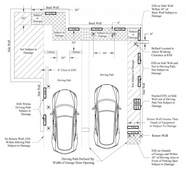fmeili1
Solar Enthusiast
HI,
I've tried to find out the current code status situation, but I'm a bit lost.
Environment:
Some sources talk about a max. of 40kWh others about max. 80kWh. Others source talk about smoke and/or heat sensor need to be installed if the capacity is between 40kWh and 80kWh. I can't find any hint about possible differences of LFP/LiFePO4 batteries compared to the more fire risk other lithium based batteries. Some sources talk about a max. of 20kWh per individual storage unit which needs to be placed 3ft from each other.
So I'm still not sure what are really the rules here?
What is the max. allowed number of 48V/100AH (5kWh) LFP batteries in total? How many of these batteries are allowed to place per rack? Can I use more batteries if the space has A/C? Can I used more if I have smoke detectors? Is there still no difference between LFP and other chemistry? Each battery "EG4-LL (V2)" has a label showing 5.1kWh - I think for marketing reasons calculated with more than 48V - I hope they will be treated as 5kWh when final inspection occur.
Is it allowed to leave the swiveling casters on the racks? Because the racks standing on the floor, what's about the minim distance between the floor and the lowest battery space?
Because the racks are located an the back (small) wall on the RV garage, is a impact/bump protection required (e.g. a car/RV may hit the battery racks)?
Maybe someone could shed a bit of light in these questions.
I've tried to find out the current code status situation, but I'm a bit lost.
Environment:
- Attached RV garage to a single family home (house/garage built 3 years ago)
- The RV garage is air conditioned.
- The batteries are in two separate server/battery racks (max. 6 batteries each) with a distance of about 5 feet between the two racks.The racks have swiveling casters (2 with breaks).
- The racks are on an inside drywall between garage and house
- cement board is mounted between drywall and server racks
- 2 smoke detectors are located on the (high) ceiling over the wall where the battery racks are located. The smoke detectors are interconnected and in case they trigger, they disconnect both battery racks from the AIO's (via two 600A relays)
Some sources talk about a max. of 40kWh others about max. 80kWh. Others source talk about smoke and/or heat sensor need to be installed if the capacity is between 40kWh and 80kWh. I can't find any hint about possible differences of LFP/LiFePO4 batteries compared to the more fire risk other lithium based batteries. Some sources talk about a max. of 20kWh per individual storage unit which needs to be placed 3ft from each other.
So I'm still not sure what are really the rules here?
What is the max. allowed number of 48V/100AH (5kWh) LFP batteries in total? How many of these batteries are allowed to place per rack? Can I use more batteries if the space has A/C? Can I used more if I have smoke detectors? Is there still no difference between LFP and other chemistry? Each battery "EG4-LL (V2)" has a label showing 5.1kWh - I think for marketing reasons calculated with more than 48V - I hope they will be treated as 5kWh when final inspection occur.
Is it allowed to leave the swiveling casters on the racks? Because the racks standing on the floor, what's about the minim distance between the floor and the lowest battery space?
Because the racks are located an the back (small) wall on the RV garage, is a impact/bump protection required (e.g. a car/RV may hit the battery racks)?
Maybe someone could shed a bit of light in these questions.




